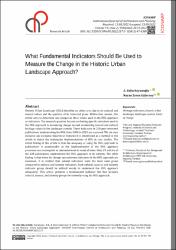| dc.contributor.author | Koyunoğlu, A. Balin | en_US |
| dc.contributor.author | Gülersoy, Nuran Zeren | en_US |
| dc.date.accessioned | 2023-02-06T09:04:45Z | |
| dc.date.available | 2023-02-06T09:04:45Z | |
| dc.date.issued | 2022-12-20 | |
| dc.identifier.citation | Koyunoğlu, A. B. & Gülersoy, N. Z. (2022). What fundamental indicators should be used to measure the change in the historic urban landscape approach?. ICONARP International Journal Of Architecture And Planning, 10(2), 596-613. doi:10.15320/ICONARP.2022.217 | en_US |
| dc.identifier.issn | 2147-9380 | |
| dc.identifier.uri | https://hdl.handle.net/11729/5343 | |
| dc.identifier.uri | http://dx.doi.org/10.15320/ICONARP.2022.217 | |
| dc.identifier.uri | https://search.trdizin.gov.tr/tr/yayin/detay/1147792 | |
| dc.description.abstract | Historic Urban Landscape (HUL) identifies an urban area due to its cultural and natural values and the qualities of its historical plane. Within this context, this article aims to determine and categorize these values used in the HUL approach as indicators. The research question focuses on finding specific indicators used in the HUL approach to measuring change beyond considering natural and cultural heritage values in the landscape context. These indicators in 228 peer-reviewed publications implementing the HUL from 2008 to 2021 are assessed. The six-step inclusive and exclusive theoretical framework is established as a method in this article to detect the inadequate implementations of HUL in case studies. The initial finding of this article is that the adequacy of using the HUL approach in publications is questionable as the implementation of the HUL approach processes was incomplete or misunderstood in most of them. Only 29 articles of the 228 publications implemented the HUL approach in its entirety. The other finding is that when the change measurement indicators in the HUL approach are examined, it is evident that natural indicators were the least used group compared to cultural and identity indicators. Each cultural, natural, and identity indicator group should be utilized evenly to implement the HUL approach adequately. This article presents a fundamental indicator list that includes cultural, natural, and identity groups for correctly using the HUL approach. | en_US |
| dc.language.iso | eng | en_US |
| dc.publisher | Konya Technical Univ | en_US |
| dc.rights | info:eu-repo/semantics/openAccess | en_US |
| dc.subject | Heritage indicators | en_US |
| dc.subject | Historic urban landscape | en_US |
| dc.subject | Landscape context | en_US |
| dc.subject | Limits of change | en_US |
| dc.subject | Heritage | en_US |
| dc.subject | Values | en_US |
| dc.subject | Cuenca | en_US |
| dc.subject | Ballarat | en_US |
| dc.subject | Naples | en_US |
| dc.subject | City | en_US |
| dc.title | What fundamental indicators should be used to measure the change in the historic urban landscape approach? | en_US |
| dc.type | article | en_US |
| dc.description.version | Publisher's Version | en_US |
| dc.relation.journal | ICONARP International Journal Of Architecture And Planning | en_US |
| dc.contributor.department | Işık Üniversitesi, Sanat, Tasarım ve Mimarlık Fakültesi, Mimarlık Bölümü | en_US |
| dc.contributor.department | Işık University, Faculty of Art, Design and Architecture, Department of Architecture | en_US |
| dc.contributor.authorID | 0000-0003-3268-7049 | |
| dc.identifier.volume | 10 | |
| dc.identifier.issue | 2 | |
| dc.identifier.startpage | 596 | |
| dc.identifier.endpage | 613 | |
| dc.peerreviewed | Yes | en_US |
| dc.publicationstatus | Published | en_US |
| dc.relation.publicationcategory | Makale - Uluslararası Hakemli Dergi - Kurum Öğretim Elemanı | en_US |
| dc.contributor.institutionauthor | Gülersoy, Nuran Zeren | en_US |
| dc.relation.index | WOS | en_US |
| dc.relation.index | TR-Dizin | en_US |
| dc.relation.index | Emerging Sources Citation Index (ESCI) | en_US |
| dc.description.wosid | WOS:000907131500009 | |


















